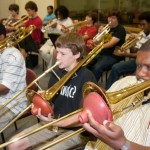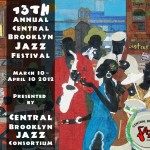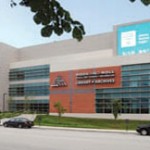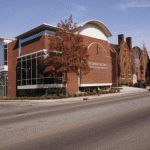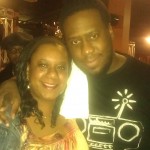
Robert Glasper backstage at Oberlin College the other night greeting one of his fans, the writer’s daughter Iyesha Jenkins.
One element of our dialogue on the black audience for creative music, as well as our conversation with Nicholas Payton (scroll down for that dialogue) and his ongoing promotion of the omnibus term “BAM” relates to the need for artists to be more audience-friendly. And by that I am certainly not advocating for outright pandering to the lowest common denominator. Several examples of what is meant by being audience-friendly hit home just over the last few days. Listening to Robert Glasper’s new disc “Black Radio” (and one could make hay on the cryptic scale for that title!) leaves this writer with a sense of a contemporary artist skillfully juggling his deeply creative and heady impulses with the music of his peers and the “body” sensibilities of those sounds. Check his recent appearance on Letterman via YouTube for video/audio evidence; balance the vocals with your sense of his acoustic piano and his rhythm section’s complex pyrotechnics (dig particularly Derrick Hodge‘s bass guitar contribution), then take into account the studio audience’s raucous response to that blend. Your commentator also recalls Payton’s recent apt reaction to the work of Glasper’s longtime drummer Chris Dave‘s traps work as more akin to Baby Dodds than Tony Williams, clearly demonstrating that these contemporary musicians, though decidedly forward-thrusting, still reflect the root.
Just finished checking out Esperanza Spalding‘s latest effort, coincidentally titled “Radio Music Society.” (Is there a common theme thread to these artists’ intentions? Seems so…) Again, this writer is struck by the melding of creative impulses and canny song selection – originals seamlessly blended with gems from Wayne Shorter and Stevie Wonder for example – mixed with vocally delivered timely thematics, like emphasizing self-pride to African American youth on “Black Gold,” and once again you get the sense of a creative, uncompromising artist who has set out to successfully craft audience-friendly sensibilities.

Last night was certainly well spent at the Bohemian Caverns on DC’s bustling U Street nightlife corridor. The subject was a unit led by young tenor & soprano saxophonist Kenneth Whalum lll, a rambunctious band that included bassist Burniss Travis, pianist Kris Bowers, and the elastic pocket of drummer Jamire Williams. In front of a pleased and packed house, Whalum and company took no prisoners on the creativity scale, performing a program laden with their originals and leavened with re-workings of nuggets from the likes of Radiohead. Yet they engaged the audience and the audience – with a significant component of 20-something black folks, including plenty of women – engaged them right back. Whalum, part of the growing Memphis music dynasty of the Whalum family (led by his uncle Kirk), has worked with the likes of Common and other prominent hip hop denizens and he brings that sensibility (ala Glasper) to an uncompromising music pallet that speaks to an audience. It ain’t all about odd meters, overly complex originals and young musicians playing for themselves. More on the Bohemian Caverns in a moment; stay tuned…

At another, though decidedly related end of the scale in DC there’s another eminent audience-friendly band, the Michael Thomas Quintet. Their trumpet playing leader is deeply steeped in Blue Note lore, particularly keen on the Art Blakey–Lee Morgan axis. Together over a dozen years, this is a ruff & ready group that likewise rejects compromise, yet at the core of its hard bop proposition is a keen sense of engaging their audience. The opening line from yesterday’s Washington Post review of their March 8 hit at the Strathmore Mansion in suburban DC says it all:
If the complex music theory and technique threaten to leach all the feeling and fun from jazz, D.C. area trumpeter Michael Thomas seems determined to bring it back. Thomas’s quintet — intact after 14 years — plays classic hard bop, but avoids cerebral labyrinths, relying on riffy melodies and playful but impassioned performances to hit the listener in the gut. That approach filled the Mansion at Strathmore’s music room Thursday night with a crowhat thrilled to the quintet’s every vibrant note.

Completed the weekend (March 9-11) with Herbie Hancock at the Kennedy Center. The KC Concert Hall was packed and Herbie delivered an exceptional, groove-oriented career retrospective of sorts – ranging back to “Canteloupe Island” and “Speak Like a Child” and covering selections from his Columbia electric records with pieces like “Actual Proof”, and even working in a return to his vocorder days with “She’ll Come Running.” The master adroitly moved from acoustic piano to the latest toys in keyboard wizardry, and trotted out his “keytar” to good effect. This tour he sports a rhythm band, with James Genus on bass guitar, relative newcomer Troy Lawrence on drums (a bit of a basher on occasion; bit too much backbeat, bit short on finesse – though admittedly this was a first sighting) and most significantly the immensely gifted guitarist from Benin, Lionel Loueke. A relaxed Hancock kibitzed with his audience, joking between pieces and strolling the stage – working the room as it were, the epitome of the original point of this screed – being audience friendly, and there ain’t nothin’ wrong with that, especially when you consider audience development the #1 challenge for creative music.


